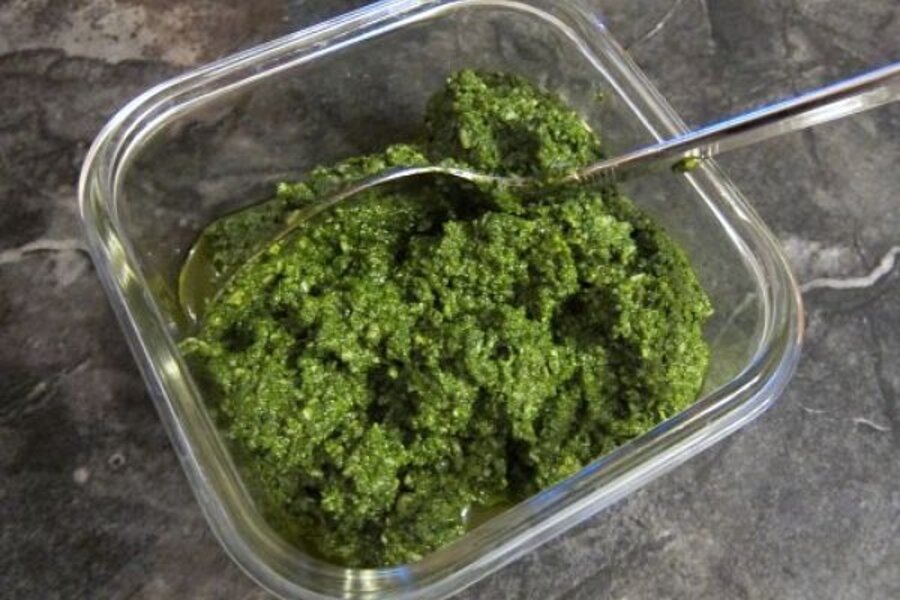Nettles for supper? Try them as pesto.
Loading...
A few weeks ago, the fiddleheads appeared at the farmer’s market. That, I believe, was the signal, even though the weather is still mostly gloomy and chilly, that it is indeed spring in Seattle. Then came the baby greens. Delicate arugula and spinach, light and translucent as fairy wings.
This week, it was stinging nettles. Nettles are one of those superfoods I am always hearing about. They can be used in recipes like spinach, steeped for tea, and are chock full of vitamins, iron, and protein.
I had a fruitful conversation with the vendor, who told me that nettles grow wild all over the US. He confirmed that nettles can be steamed and eaten much like any other greens. It occurred to me that handling the raw stinging nettles could be problematic. They do have the word stinging right in their name after all, and I have a vivid memory of brushing my exposed ankle, ever so lightly, against a weed while I was on a walking trip in England last year, and the sudden, acute burning sensation produced.
“Don’t touch them to sensitive parts of your body like your inner arms and you’ll be just fine. And they don’t sting at all after they are cooked,” he explained. “But yeah, while you are washing the raw nettles, you might want to use tongs to handle them.”
Another shopper chimed in (which is part of the fun of the farmer’s market), “Oh, they lose their sting pretty quickly after they are picked,” she said, “and these top leaves don’t have much sting anyway.”
The vendor continued: “Your hands won’t be bothered too much.”
Then they both picked a leaf off the top of the pile and demonstrated, rubbing them with their fingers. “See? I’m fine!”
Thus reassured, I took my bag of nettles and escaped to the sting-free zone of the flower vendor.
Stinging nettle pesto is not difficult to make, but it does take some time to strip the leaves from the stems, which to my mind makes this a Sunday afternoon sort of recipe.
This pesto is mild and rich, with a surprisingly savory umami flavor – it is similar to a Swiss chard or spinach pesto, with just a hint of mint. There is a freshness about it that really does taste bright green, like a taste of spring. Stir it into hot pasta, spoon over baked potatoes, or toss with hot roasted vegetables. Nettle pesto can be used just like a classic basil pesto.
Nettle pesto
Adapted from 'Lucid Food: Cooking for an Eco-Conscious Life' by Louisa Shafia
Makes approximately 2 cups
Salt and freshly ground black pepper
1/4 pound stinging nettles
1 clove garlic, minced
1/2 cup pine nuts
2 tablespoons lemon juice
1/2 cup olive oil
1/2 cup grated Parmigiano Reggiano cheese
Fill a large pot halfway full with water. Add several pinches of salt and bring to a boil.
Fill the sink or a large bowl with cold water. Using gloves, submerge the nettles in the water and let them sit for 5 minutes. Remove the nettles and discard the water. Wearing rubber gloves, pull the leaves from the stems and discard the stems.
Put the nettles in the boiling water and boil for 1 minute. Drain and let cool. Squeeze out as much of the water as possible and coarsely chop.
In a food processor or with immersion blender, process the nettles with the garlic, pine nuts, and lemon juice until smooth.
With the machine running, pour in the olive oil. Transfer to a bowl and fold in the cheese. Season with salt and pepper to taste.
Christina Masters blogs at The Rowdy Chowgirl.
To comment on the original post, click here.
To receive Monitor recipes weekly sign-up here!
--------------------------------------------------------------
The Christian Science Monitor has assembled a diverse group of food bloggers. Our guest bloggers are not employed or directed by The Monitor and the views expressed are the bloggers' own and they are responsible for the content of their blogs and their recipes. All readers are free to make ingredient substitutions to satisfy their dietary preferences, including not using wine (or substituting cooking wine) when a recipe calls for it. To contact us about a blogger, click here.





